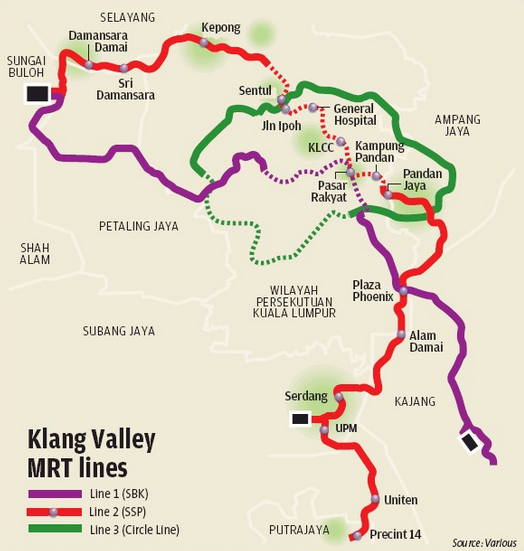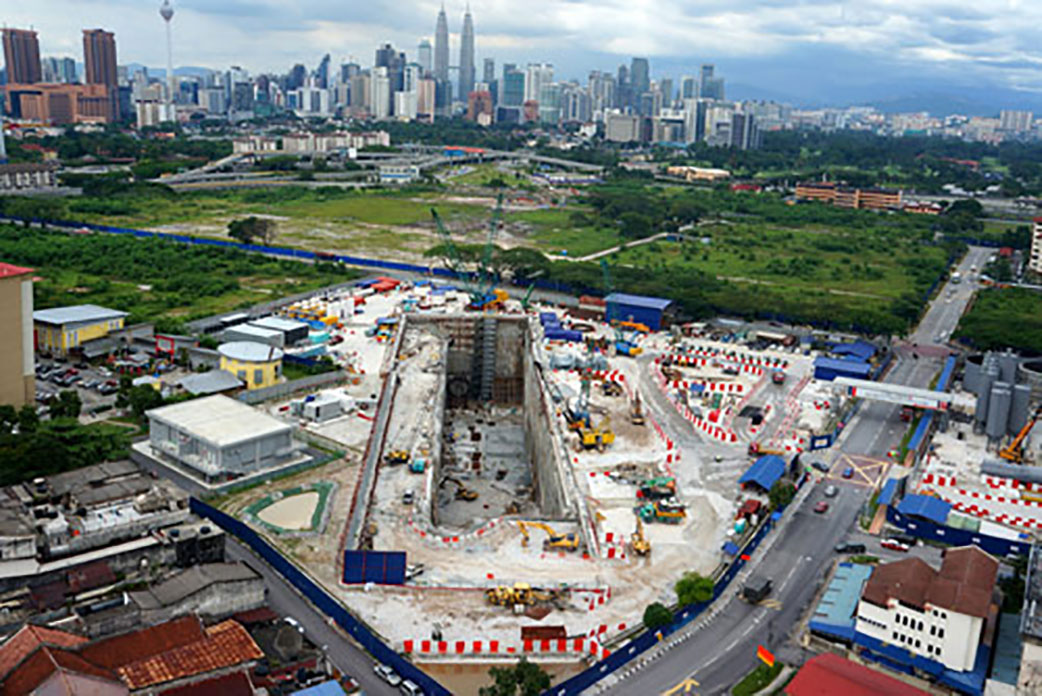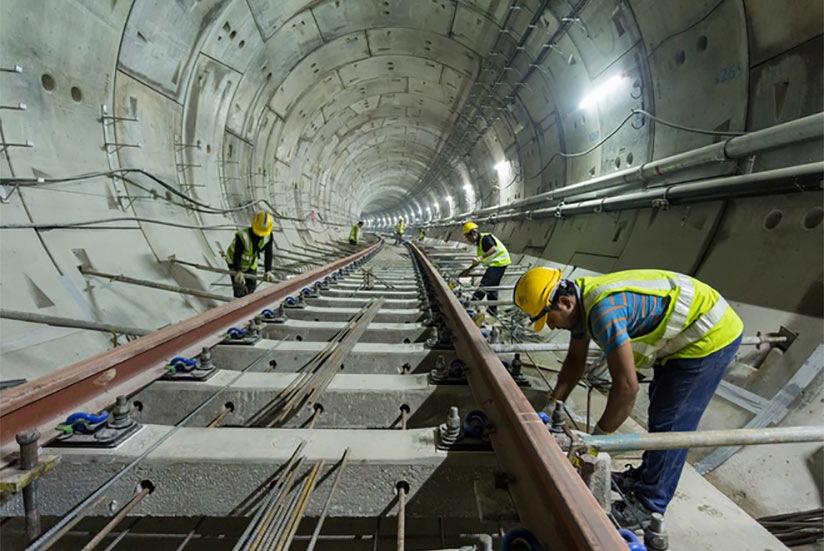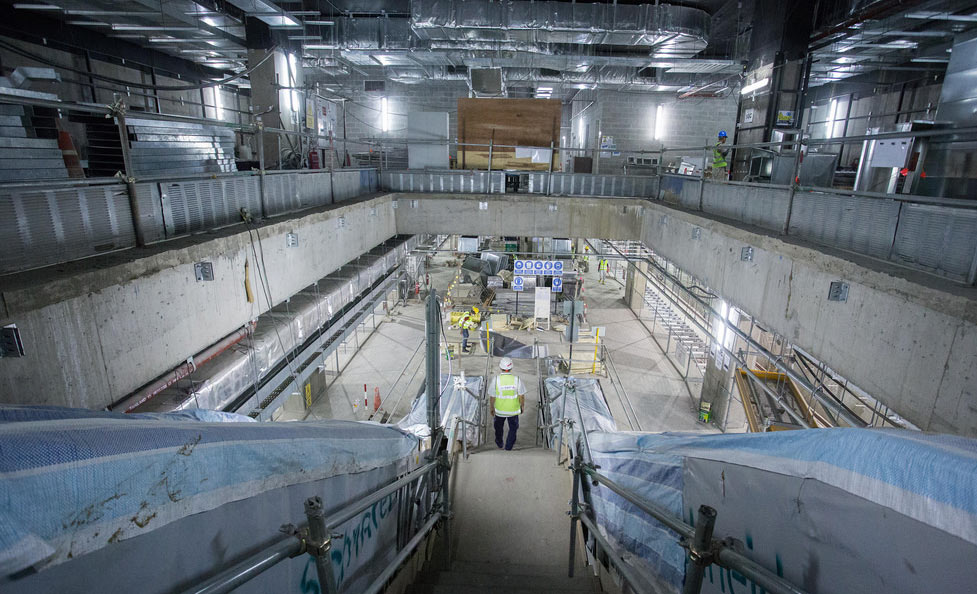Kuala Lumpur has decided to duplicate the underground success of its Line 1 MRT on Line 2 – same team, same TBMs, same lining, same contractual setup.
This is confirmed with award on 31 March 2016 of the 13.5km underground section of Line 2 to the MMC GAMUDA KVMRT JV (MGKT). MGKT successfully completed excavation of the underground section of Line 1 in April last year (2015) when the last of ten TBMs procured for the project broke through into Pasar Seni Station. Line 2 with 13.5km of twin tube tunnels running between 11 underground stations will be repeat of the Line 1 operations to excavate 9.5km of twin running tunnels between seven open-cut underground stations.
Award of the RM 15.47 billion (about US$4 billion) was announced by MRT Corp, the Mass Rapid Transit Corporation, of the Malaysian Government, following a One Stop Procurement Committee (OS PC) meeting chaired by Prime Minister Dato' Sri Mohd Najib Tun Abdul Razak. The central underground section is the largest work package for the construction of the new 52.2km long Sungai Buloh-Serdang-Putrajaya (SSP) Line 2.
The underground works contract involves the design, construction and completion of tunnels, underground stations and associated structures such as portals and escape shafts for the 13.5km underground alignment from the Jalan Ipoh north escape shaft to the Desa Waterpark south portal.
MRT Corp Chief Executive Officer Dato' Sri Shahril Mokhtar said: "The working relationship between MRT Corp and MGKT began with the MRT Sungai Buloh-Kajang Line 1 and this good relationship can now continue with the SSP Line. The team has a proven track record of working in the challenging geology of the Klang Valley.”
Shahril said as with all work packages, the successful tender was selected on the basis of best evaluated tender, where it was evaluated on technical and commercial criteria and not necessarily the bid with the lowest price. "Nevertheless, for this tender, I can reveal that the best evaluated tender had the best score for the technical evaluation and also had the lowest price," he said.
Five companies were shortlisted during the pre-qualification stage and four submitted tenders. Along with MGKT, the other shortlisted companies were:
- China Railway Group Limited (CREC)
- China Communications Construction Company Ltd
- Hyundai Engineering and Construction Company Ltd and
- Taisei Corporation, which declined to submit a proposal
While MGKT did have the previous experience advantage, the competition from the Chinese bidders was said to be strong. As well as keen prices, there are historical and cultural connections between China and Malaysia. The competition provided for tough client negotiations between the bidders but the decision favoured previous experience and the benefit that the local joint venture will retain the commercial benefits within Malaysia and that it will support local employment opportunities.
Following the announcement, TunnelTalk connected with Gus Klados, Director of Tunnelling for MGKT, who held the similar position for the Line 1 underground works, to know more about the tunnelling strategy. “We delivered a good job for MRT Corp with Line 1 and we plan to complete the Line 2 contract in the same way,” said Klados. “We retained the six Variable Density VD TBMs and the two EPBMs that we procured from Herrenknecht for Line 1 and these are currently being refurbished at a workshop near Ipoh in Malaysia for reuse on Line 2. To these we will add four new VD machines from Herrenknecht for the extra length of the 13.5km long Line 2 running tunnels.”
A large part of the new contract is aligned through the same highly karstic limestone beneath the city and for which the VD machines were designed specifically. In one drive the VD machines will be best able to manage complex geology where granite, its residual soils with boulders and karst will be encountered. The two EPBMs will operate through the generally silty clay deposits of the Kenny Hill Formation.
“The VD machines operated very well in the karstic limestone,” said Klados, “and they operated well also through the Kenny Hill Formation. Two of the VD machines that progressed from the Inai shaft location, first through karstic limestone and then into the Kenny Hill Formation proved to be truly dual mode systems. They operated in the variable density slurry TBM mode through the limestone, with the slurry being adjusted in density to cope with porosity and voids of the karst geology, and were converted to work as classic EPB systems in the silty clay.”
The dual mode was possible because the machines, in both the slurry and EPB mode, extracted material from the excavation chamber via a screw conveyor. In slurry mode, material passed from the screw conveyor discharge through a slurrifier box to optimize the density for pumping through the slurry circuit to the separation plant. “In EPB mode, we disconnected the slurrifier box and slurry pipeline and inserted a belt conveyor that transferred the silty clay material from the screw conveyor discharge to trains of muck skips for haulage,” said Klados. “The conversion took about seven days and was well worth the modification as advance in the EPB mode could be optimized rather than being limited by using the slurry circuit and sending the material to pass through the separation plant. The backup of the VD machines and their systems were designed to accommodate fast conversion. These machines can also operate in EPB mode with material transport in the slurry system. In this case the ‘conversion’ is a matter of resetting operation parameters in the operator’s cabin. No physical conversion is required.”
Continuous conveyor mucking in the converted EPB mode was not installed as this would have been a much more expensive option than loco and skip muck haulage. “The comparison was about MR 18 million for continuous conveyors to MR 1.8 million for the fleet of used skips and locos. The drives were too short for economic use of a continuous conveyor system,” said Klados. “Long distance and high speed advance is needed to get the best from continuous conveyor systems.”
Once converted to EPB mode from VD slurry mode, and if the pipes of the slurry circulation system are extended with tunnel advance, conversion back to slurry is also readily possible. “We did not continue extension of the slurry system pipes for the TBMs as the ground conditions were expected to stay in the EPB favourable silty clay deposits.”
In the slurry mode, the Variable Density machines also earned their worth. “The karstic conditions where as bad as they were on the SMART tunnel excavation that we completed in early 2007,” said Klados. “We had two standard slurry machines on that project and we did suffer about 50 sinkholes and escape of slurry to the surface. This did cause disruption to the city streets and delays in tunnelling. There was no serious consequence as a result and all incidences were quickly managed and resolved, but the experience was the foundation for the development with Herrenknecht of the Variable Density concept. Increasing the density of the slurry to prevent loss of slurry and therefore face pressure through the karstic conditions proved its worth on Line 1 on which we experienced only two sinkhole incidents. A significant improvement.” Klados also commented that the PLC systems that managed operating parameters of the VD machines contributed considerably to the success of the systems. “We did complete comprehensive programmes of geophysical survey to identify major karst features on the alignment of the TBMs and we did also follow a programme of pre-excavation grouting in certain areas but, due to the capabilitites of the VD slurry system, this was much less than was required on the SMART project.”
On route, Line 2 running tunnels will pass under the combined stormwater and road SMART tunnel and to a depth of some 60m. The VD machines to be used on the drive are being upgraded to cope with this higher, potential 6 bar working pressure. The launch station box for the two machines for the SMART underpass are about 40m deep and will require drill+blast excavation within 100m of the SMART tunnel.
An added modification of the VD TBMs will be upgrade of their stone crusher. The stone crusher is on the outside of the plenum on the machines just before the slurrifier box and was of the drum roller type. This caused some troubles during the Line 1 drives. Stones tended to bounce on the top of the rollers and the unit was difficult to clear. “We have conducted a lot of tests for improving the performance of the units,” said Klados, “and after crushing more than 200 tonne of granite and limestone of various strengths in the workshop in Ipoh and using different designs and crusher bit tools, we have chosen the best performing configuration and the new units are ready for fitting.”
Behind the same TBMs as used on Line 1, MGKT will install the same design of precast steel fibre reinforced segmental linings. “I am an advocate of steel fibre reinforced segments and we worked hard to convince the designers on the project to adopt the design for Line 1,” said Klados. “The greatest detraction of the concept by designers is that there are no universally accepted standards for the design of steel fibre reinforced segments but the experience, performance and laboratory testing of the materials around the world has confirmed the applicability of the system. Only in about 2km of a total near 20km of segmentally lined tunnels did we use a hybrid design of fibres in conjunction with rebar cages to increase the bending moment of the segment rings to suit local loading conditions.”
The segments will be cast using the same sets of refurbished moulds that were supplied by Unicrane and Herrenknecht for the first project.
With the advantage of owning the eight Herrenknecht TBMs needed for the project – six VD machines and two EPBMs – as well as the segment design and production plant, MGKT was able to pass on these savings into its bid. The RM15.47 billion (about US$4 billion) contract for the central 13.5km and 11 stations of the underground works for Line 2 compares to a contract award price of RM 8.28 billion (about US$2.1 billion) for the 9.5km and seven stations of the underground section for Line 1 five years ago. This includes a rate of inflation of about 5% per annum across the five years.
Construction of the total 52.2km long SSP Line with 37 stations, 13.5km and 11 stations underground, is divided into 66 work packages:
- 10 viaduct guideway packages
- one underground works package
- two depot work packages
- 10 station work packages and
- 15 multi-storey park and ride work packages
The remaining tenders are for advance works, connectivity, systems, designated suppliers and designated contractors.
Award of the single underground construction package is the third major civil and infrastructure works package to be awarded following earlier award of:
- Work Package V202 for the viaduct guideway and other associated works for a 4.5km stretch of the SSP Line from Persiaran Dagang to Jinjang to Ahmad Zaki Sdn Bhd for a contract sum of RM1.44 billion (US$370 million) and
- Work Package V201 for the viaduct guideway for a 4.9km stretch from Sungai Buloh to Persiaran Dagang to Sunway Construction Sdn Bhd for RM1.21 billion (US$310 million).
MRT Corp is expected to issue the Letter of Award to MGKT in the coming weeks and work on site is likely to start in May 2016. Unlike Line 1, where enabling works were advanced ahead of the main construction contract award, these utility relocations and preparatory works are yet to start for Line 2. Arup, as the project designer to the MRT Corp, has also designed the running tunnels to be advanced from the open-cut station boxes rather than from separate ventilation/access and TBM working shafts as was the case on Line 1. The Inai shafts and the Pudu shaft on Line 1 were designed as TBM launch and operating sites as a contractor’s initiative to reduce the interface impact of tunnelling on the station works. Unfortunately land acquisition and geological issues at the Inai shaft location, made this arrangement costly and unweildy. MGKT has decidednot to go for similar arrangements on Line 2 which will require station boxes to be excavated to tunnel invert level before TBMs can be launched.
Tunnelling by the eight refurbished and four new VD machines for the project is expected to start towards the end of 2017 and to be finished by the end of 2019. Station construction and fit-out will then advance towards a completion date of December 2021. Line 2 opening for service is planned for May 2022.
In the meantime, the first stage opening on Sungai Buloh - Kajang (SBK) Line 1, the surface and elevated section from Sungai Buloh and Semantan stations, just north of the underground section is planned to be opened for services at the end of 2016. The remainder of the Line, including the underground section, is on schedule to be opened as planned in July 2017.
References
- Final breakthrough ends KVMRT TBM tunnelling – TunnelTalk, April 2015
- New design TBM tames the Kuala Lumpur karst – TunnelTalk, January 2014
- KVMRT Line 2 releases tender documents – TunnelTalk, October 2015
|
|
|
|
|
Add your comment
- Thank you for taking the time to share your thoughts and comments. You share in the wider tunnelling community, so please keep your comments smart and civil. Don't attack other readers personally, and keep your language professional.








